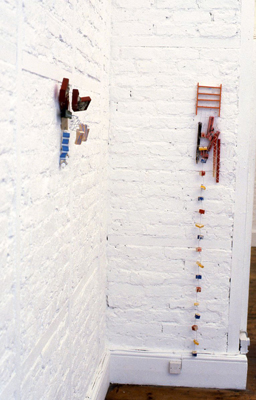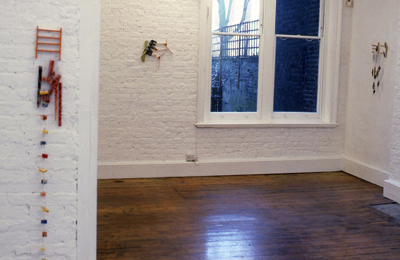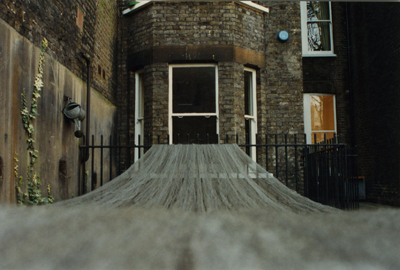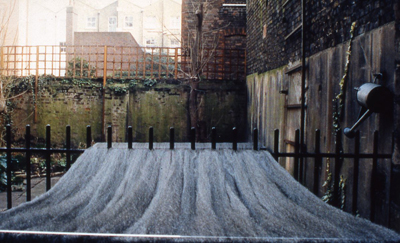Fennick-Streather
- Bobbie Fennick – Elements
- Bobbie Fennick, Elements – Jean-Paul Martinon
- Simon Streather – Objects
- Simon Streather, Objects – Jean-Paul Martinon
Rear
Window Publications
1993 © Jean-Paul
Martinon
On each side and along the walls of Rear Window’s back yard lie half dead flowerbeds, sprouting fig trees and bushes. From one end of the yard to the other, floats a river of shredded steel 3 feet above ground level. It is light and elusive. It springs from an old rusted display cabinet made of steel, travels through the garden, gets combed by some railing and finally runs into the large bow window of the house—a large four storey Victorian terraced house—at the back of the gallery. Inside, at the other end/beginning, the shredded steel springs again from a perfectly clean display cabinet, this time covered by a sheet of glass. The lighting highlights the texture of the material, its shininess, and its fabric quality.
Either outside or inside, everything is frail and fragile looking, cold and humid, insecure and unprotected. Time will have slowly undergone a long and laborious work over the elements: the tress, the shrubs, the shredded steel, the cabinets, the window, and even the rooms inside the house.
Like any rusting element, words cannot capture the momentum in life -words also rust. One can only hope to show (or write about) traces of time. As the French philosopher Alain put it: “For how long can time stop its course?” For how long can one freeze, admire and perverse the flickering of leaves, the flying bird across the sky or the subtle stages of rusting on shredded steel? For how long can one hold the present?
What Bobbie Fennick appears first to be showing us in this garden is a slice of present. Not the present but a momentum in the usual ageing process. For that purpose, she uses a material made of steel. But a steel which doesn’t carry its usual qualities of strength and invulnerability. The shredding process transforms it into a material that is useless to sustain bridges or skyscrapers, a soft and malleable ambiguous material that can web and meander like shreds of wool.
The shredded steel (or steel wool) strangely manages to carry its own individual existence, its own manufactured essence and its own contradiction. An epistemological contradiction that lies between the material itself (the steel) and the consequence of the manufactured process of shredding (the wool); between the hard, cold and aggressive steel and the figuratively soft, hot and comforting wool.
This essential contradiction makes it a material lacking in unity. A material split into thousands of shreds, each of them fighting for a unifying identity. Its desperate balancing between its roughness and its softness makes it somehow a perfect two-edges material in artist’s hands and placed outside, unprotected, exemplifies the impermanence and fickleness that pervades in all things - natural and manufactured.
Like an imaginary floating river or like a spider’s web, Bobbie Fennick’s
installation spread out through the garden. From one rusted open-air epicentre
to an environmentally protected vitrine inside the house. The steel wool travels
through the garden/time letting itself permeate with rust and dirt. Slowly
from one end to another, the elements -the steelwool, the rust, the reddish
stains- create a structure of their own. The wind can change its route, the
rain can alter its thickness and its weight; the structure will reset itself
on another geometry. Unconstrained and anti-formal, Bobbie Fennick’s
structure lets itself sway by the rhythm of time and manages to be indefinitely
reconstructed and deconstructed, constantly losing and gaining back its ambivalent
identity.
By refusing the sculpture’s gesturality, and by leaving her structure
in a state of flux, Bobbie Fennick brings to life a paradoxical geometry. As
for the art of Eva Hesse and particularly for her piece entitled “Metronomic
Irregularity” (1966), the artist challenges here our understanding of
structure -of contrived structure - and by unifying her work with nature creates
what one could call a unique organic order where the curve of the tree and
the irregularities of the wall are part. Her elements build p to an irrational
and intricate (super)structure whose complexity equals the webbing of the shredded
membranes.
This organic order allows us to experience an emotional unifying process . The mingling with outside patterns, the respect of the garden’s geometry takes us on an indoor-outdoor “rusting journey”. Bobbie Fennick’s art escapes the definite forms of language, and becomes an art-in-process, an art-as-gestalt. Needless to say that in an Arte Povera way, Bobbie Fennick gives value the mobility of materials and structure. The rust, the wind, the city dust, the ageing process, every revolving element is there to highlight the fact that nothing is phenomenologically inert, static or even separated from other phenomena. This attitude vis-a-vis creation is not “environmentally conscious”. It has to do with fluidity and movement. It analyses the potential for change lying within all elements. A potential that constantly projects itself—not ahead nor backwards—but within time. We could compare Bobbie Fennick’s rusting steel with Beuys’ use of fat and its reaction to temperature. But her concept of movement within what is static is other. It refers more to the Heideggerian ontological “da-sein” (being-there), which gives elements a time-span intentionality. The movement of a leaf falling from a tree or the stains of rust on the paving stones are in themselves that intentionality. They are individual projections within a world of projections. However, Bobbie Fennick doesn’t load the materials she uses with anthropomorphic or ontological dimensions; she pushes us to see the changes that occur in seemingly inanimate elements, freeing them and us from the terror of objective reductionism and lifting them to the status of charged elements.
By letting her elements take on their own individual existence, she explores the complexity of creation, the power game between human and organic forces. There is no attempt on her side to break, to halt, retard, fight or even escape natural processes. She ultimately confronts our insecurities about decay, deterioration and of course, about death. And this is where the steel vitrines come in: they underline the endless efforts of galleries and museums in preserving works of art from deterioration. Endless efforts that seem to forget that alongside the artist time is a Master as well. Each crack, each blister, each sign of decay on a painting, a mural a sculpture or an installation are inevitably part of the piece. There is no attempt here to criticise the art of conservation, but by installing a temporary site-specific work to question the ageing of works of art.
Bobbie Fennick, like many other artists conscious of their own historicity, underlines and questions our preconceived ideas about time and our notions of the present. Encompassing traditional views on such subjects (for example the idea that past and future mingle together in the present) and by using such an ambiguous and human-like material, Bobbie Fennick manages to suggest the impossible: to sculpt the present. And watch out: Here you are, standing in front of this floating shredded steel, watching a certain -a resent- stage of rust, questioning the relevance of the display, the steel cabinets, the threads and the wind blowing through its membranes, waiting for the next moment aware of where you stand and of the past few minutes you’ve just lived, indefinitely locked in this un-definable Present, and like the artist, forever curious of its intricate and questionable presence.







